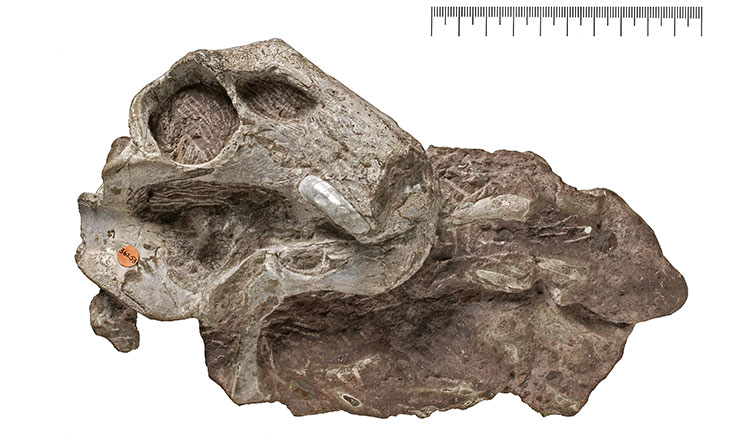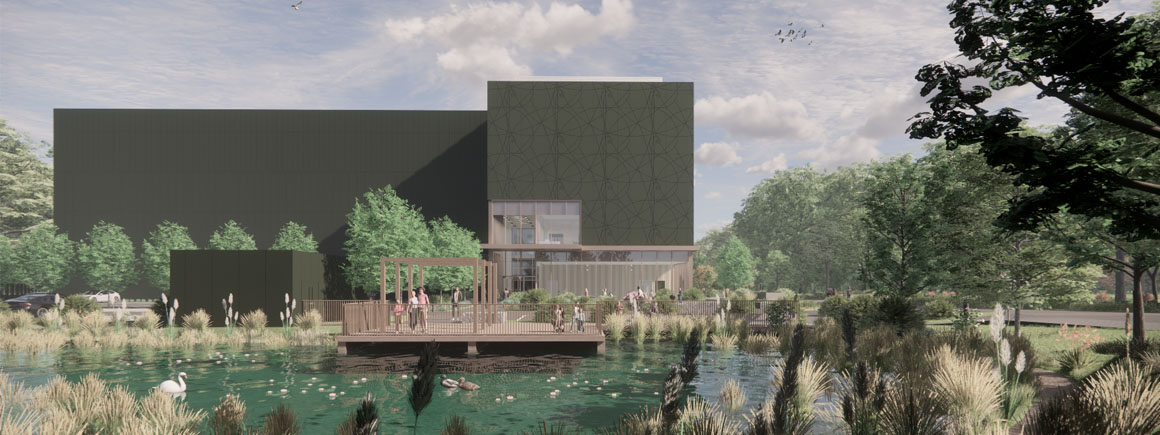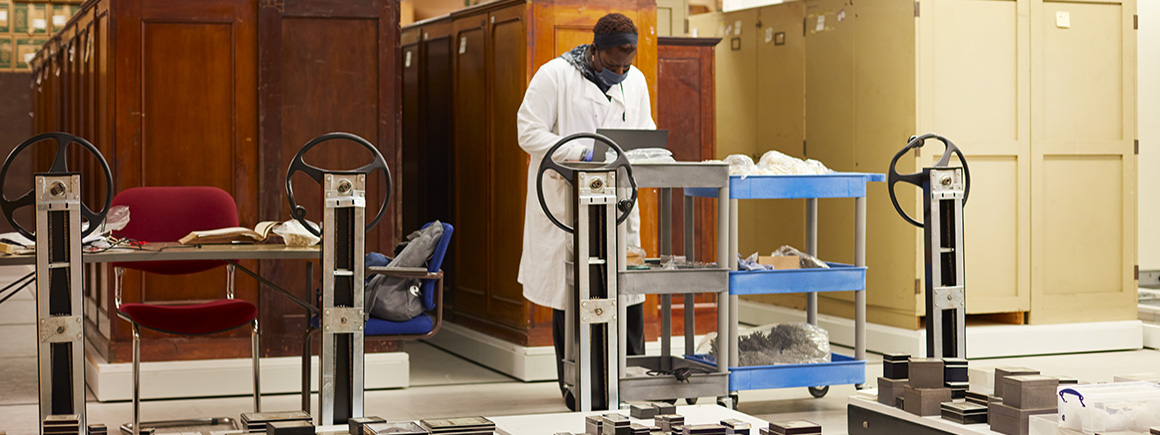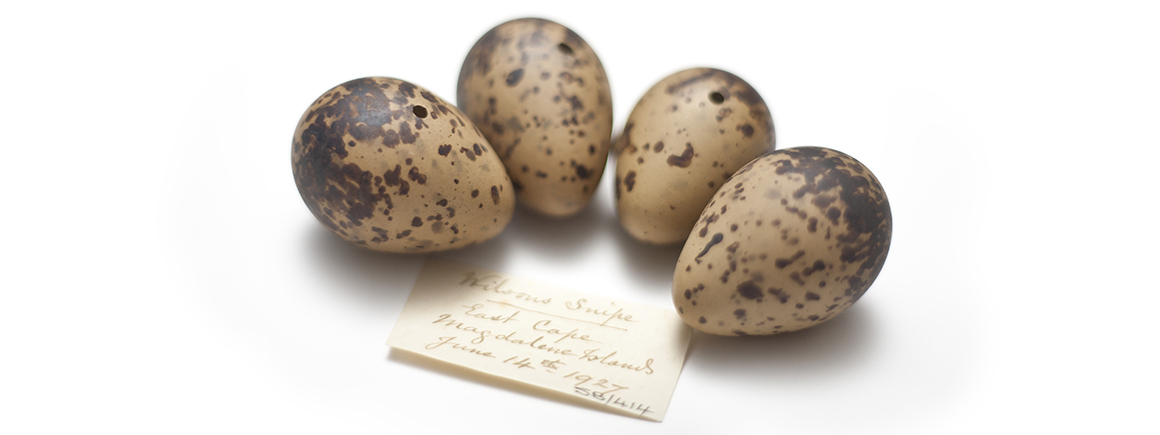Specimens
3,380

Fossil skull of the extinct cynodont therapsid Cynognathus crateronotus. Cynognathus was a powerful predator that was close to being a mammal, but not quite. It has been found in several parts of southern Africa, which has helped determine a similar age for the fossil assemblages in which it is found. This excellent skeleton was found in 1881 in the Eastern Cape, by the English palaeontologist Harry Seeley.
3,380
84
The Museum’s collection contains over 3,000 specimens, including a large amount of material from Africa.
The Synapsid and Parareptile Collection includes both non-mammalian synapsids and Mesozoic mammaliaformes. The first collections at the Museum were acquired in 1853, with the transfer from the Geological Society of London of Andrew Geddes Bain’s South African fossil vertebrate collection. The South African element was expanded in the 19th Century by a coterie of amateur palaeontologists operating in the Cape of Good Hope (South Africa), as well as the occasional travelling aristocrat. From 1889, when Harry Seeley visited the Cape, fossils were increasingly donated or sold to the Museum by professional palaeontologists.
Meanwhile, the purchase of the Beckles collection in 1876 brought in the first Mesozoic mammaliaformes from the UK, in this case from the Purbeck Group (Early Cretaceous) of Dorset. This part of the collection grew significantly with the acquisition of the Kenneth Kermack collection of mammaliaformes from the Triassic/Jurassic Welsh fissure localities of Wales and South West England. Further fieldwork by Museum staff has added much more material in recent years, notably from Woodeaton in Oxfordshire.
The collection is still expanding, with the most recent donation of over 100 fossil therapsids and pareiasaurs being made in 2017. With over 80 holotype specimens and a broad taxonomic spread, the Synapsid Collection is one of the most important in the world. It is actively visited by scientists who use it to study the origin of mammals and the evolution of the mammalian ancestors. This includes research into their functional anatomy, ecology, metabolism, and diversity, as well as the evolutionary processes that drove these developments.
Because the parareptiles at the Museum also come mostly from the same localities as the synapsids, and are few in number, they are grouped together.
The Palaeontology collection is being digitised
If you would like to use any specimens for research
The synapsid collection is rich in holotypes, so remains a vital destination for taxonomists. These include: Dicynodon lacerticeps Owen 1845, Endothiodon bathystoma Owen 1876, Cynognathus craternotus Seeley 1895, Thrinaxodon liorhinus Seeley 1894, Moschorhinus kitchingi Broom 1920, Eunotosaurus africanus Seeley 1892, and Pareiasaurus serridens Owen 1876.
We also have some very complete and well-preserved specimens, such as Bradysaurus baini, Procynosuchus delaharpae, and Endothiodon bathystoma.
Although the South African material is extensive, the Synapsid and Parareptile Collection at the NHM incorporates a large number of fossils from Zambia and Tanzania collected in two fieldtrips in 1963 and 1974. It is perhaps the best single collection of Zambian and Tanzanian fossil synapsids in the world.
The collection is also renowned for its Mesozoic mammaliaformes, most notably for its early Purbeck mammals, the vast collection of Morganucodon and Kuehneotherium from the Kermack collection of Wales and SW England, and the holotype of Megazostrodon from the Early Jurassic of Lesotho.

Fossil skull and lower jaw of the dicynodont Lystrosaurus murrayi, originally described as the holotype of Ptychognathus boopis by Richard Owen in 1876. This South African fossil was presented to the Museum in 1858 by the then governor of Cape Colony, Sir George Grey. Lystrosaurus thrived immediately after the greatest mass extinction in Earth’s history, at the end of the Permian period, 251 million years ago.
Many of the fossils in the synapsid collection, particularly the older material, were acquired through donations by, or purchases from, collectors based in South Africa. These were collected over unspecified periods of time, rather than in discrete expeditions. But a few key collections came to the Museum resulting from fieldwork conducted by UK-based palaeontologists in South Africa, and later Zambia and Tanzania. These are, primarily:
Several exchanges were made with other museums both in the UK and abroad, with several significant collections, including casts, being obtained from institutions in the USA, Russia and Argentina.
Mao, F., Brewer, P., Hooker, J.J. and Meng, J., 2022. New allotherian specimens from the Middle Jurassic Woodeaton Quarry (Oxfordshire) and implications for haramiyidan diversity and phylogeny. Journal of Systematic Palaeontology, 20(1), pp.1-37. https://doi.org/10.1080/14772019.2022.2097021
Pusch, L.C., Kammerer, C.F. and Fröbisch, J., 2021. Cranial anatomy of Bolotridon frerensis, an enigmatic cynodont from the Middle Triassic of South Africa, and its phylogenetic significance. PeerJ, 9, p.e11542. https://doi.org/10.7717/peerj.11542
Van den Brandt, M.J., Abdala, F., Benoit, J., Day, M.O., Groenewald, D.P. and Rubidge, B.S., 2021. Taxonomy, phylogeny and stratigraphical ranges of middle Permian pareiasaurs from the Karoo Basin of South Africa. Journal of Systematic Palaeontology, 19(19), pp.1367-1393. https://doi.org/10.1080/14772019.2022.2035440
Newham, E., Gill, P.G., Brewer, P., Benton, M.J., Fernandez, V., Gostling, N.J., Haberthür, D., Jernvall, J., Kankaanpää, T., Kallonen, A. and Navarro, C., 2020. Reptile-like physiology in Early Jurassic stem-mammals. Nature communications, 11(1), pp.1-13. https://doi.org/10.1038/s41467-020-18898-4
Spindler, F., 2020. Re-evaluation of an early sphenacodontian synapsid from the Lower Permian of England. Earth and Environmental Science Transactions of the Royal Society of Edinburgh, 111(1), pp.27-37. https://doi.org/10.1017/S175569101900015X
Kammerer, C. F., K. D. Angielczyk, and S. J. Nesbitt. 2017. Novel hind limb morphology in a kannemeyeriiform dicynodont from the Manda Beds (Songea Group, Ruhuhu Basin) of Tanzania; pp. 178–188 in C. A. Sidor and S. J. Nesbitt (eds.), Vertebrate and Climatic Evolution in the Triassic Rift Basins of Tanzania and Zambia. Society of Vertebrate Paleontology Memoir 17. Journal of Vertebrate Paleontology 37 (6, Supplement).
Fernando Abdala, Christian F. Kammerer, Michael O. Day, Sifelani Jirah, Bruce S. Rubidge. 2014. Adult morphology of the therocephalian Simorhinella baini from the middle Permian of South Africa and the taxonomy, paleobiogeography, and temporal distribution of the Lycosuchidae. Journal of Paleontology; 88 (6): 1139–1153.
Liu J., Abdala F. 2014. Phylogeny and Taxonomy of the Traversodontidae. In: Kammerer C., Angielczyk K., Fröbisch J. (eds) Early Evolutionary History of the Synapsida. Vertebrate Paleobiology and Paleoanthropology. Springer, Dordrecht.
Abdala F., Jashashvili T., Rubidge B.S., van den Heever J. 2014. New Material of Microgomphodon oligocynus(Eutherapsida, Therocephalia) and the Taxonomy of Southern African Bauriidae. In: Kammerer C., Angielczyk K., Fröbisch J. (eds) Early Evolutionary History of the Synapsida. Vertebrate Paleobiology and Paleoanthropology. Springer, Dordrecht.
Christian F. Kammerer, Kenneth D. Angielczyk & Jörg Fröbisch (2011) A comprehensive taxonomic revision of Dicynodon (Therapsida, Anomodontia) and its implications for dicynodont phylogeny, biogeography, and biostratigraphy, Journal of Vertebrate Paleontology, 31:sup1, 1-158.

Access to some collections will be affected as we prepare for the move to our new collections, science and digitisation centre.

Scientists and collections management specialists can visit the collections and borrow specimens for research.

Our duty is to provide a safe and secure environment for all of our collections.